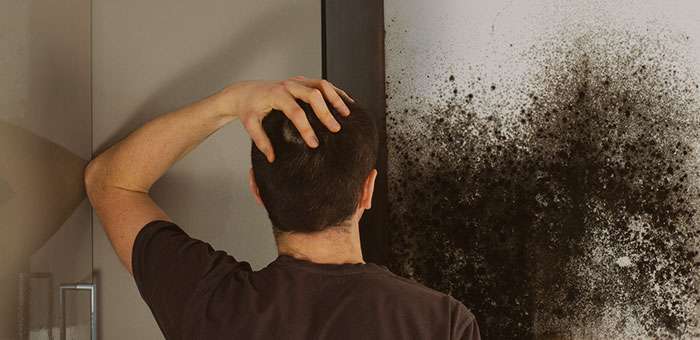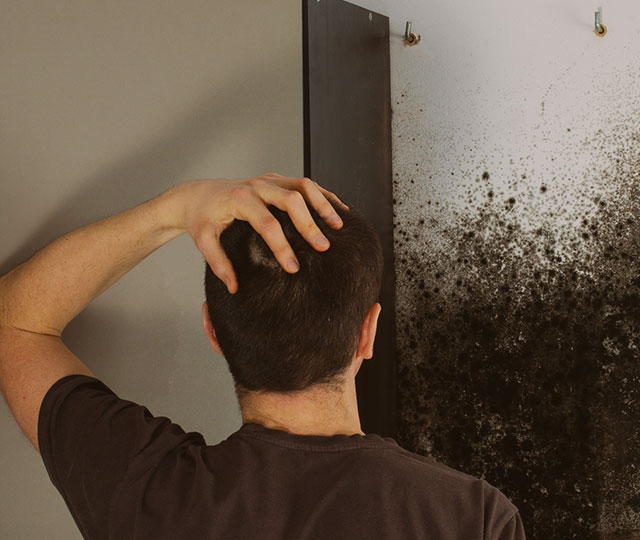Black Mold, Toxic Mold, Toxic Black Mold
No scare tactics, just straight talk and the information you need.
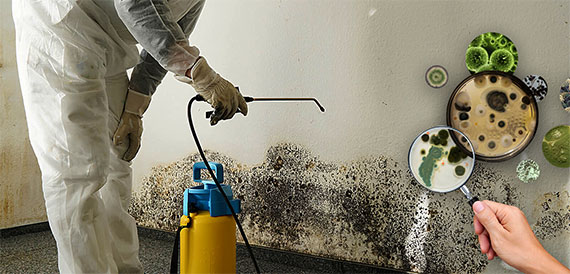
-
Black Mold Basics
What is it and is color an indicator?
-
Mold Toxicity Explanation
Mycotoxins
-
What if you find out you have Stachybotrys?
-
Helpful resources
Black Mold Basics
Q: What is it? What is black mold, toxic black mold and the combo toxic black Mold?
Answer: All of the terms listed above are media terms and not mycology or laboratory terminology. You will not find “Black Mold” in reference books or medical dictionaries.
However, we know what you are talking about when you ask about the BLACK mold. Usually when a customer asks about Black mold, what he/she is referring to is the genus of mold called of Stachybotrys. Stachybotrys was given the common name “BLACK mold” back in the late 1990s and early 2000s during the heavy media coverage of infant deaths. The media reported that infants died from lung hemorrhages from exposure to Toxic Black Mold, Stachybotrys.
Here is the current stance the CDC has on that particular subject:
“Does Stachybotrys chartarum (Stachybotrys atra) cause acute idiopathic pulmonary hemorrhage among infants?” (1)
CDC states:
“To date, a possible association between acute idiopathic pulmonary hemorrhage among infants and Stachybotrys chartarum (Stachybotrys atra) has not been proved. Further studies are needed to determine what causes acute idiopathic hemorrhage.” (1)
What you will find in a laboratory reference book is that Stachybotrys is “commonly considered a contaminant. Stachybotrys alternans produces a potent toxin that is lethal to animals eating contaminated forage. Inhalation or percutaneous absorption has caused mild symptoms in humans” (2)
Stachybotrys is a greenish-blackish mold that grows well on cellulose containing materials. Cellulose is wood, so things like paper, lumber, paper backing on sheetrock, fiberboard and some textiles etc. are frequent sources of contamination indoors.
Q: Is Color an Indicator?
Answer: Although Stachybotrys is black in color, so are many other types of mold. Do not assume you have Stachybotrys just because the mold is black.
Below are a few examples of other types of mold besides Stachybotrys that can appear black in color.
- Aspergillus niger
- Chaetomium
- Nigrospora
- Auerobasidium
- Alternaria
- Memnoniella
Do not make a common mistake and discount the importance of other types of mold that you may find simply because the mold you see is not black.
Bottom line: Don’t let the color of mold be an indicator of potential hazard level.
• Did you know that the same mold can be different colors depending on what it is growing on?
Below are two examples of how the same mold looks visibly different depending on what substrate it is growing on.
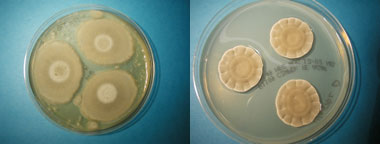
Figure 1
Both pictures above contain the same species of Penicllium, but notice how differently they appear. The difference is due to the type of agar (gel) the mold is growing on
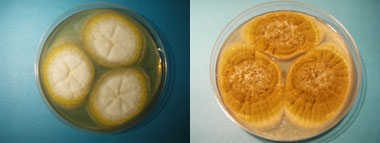
Figure 2
Again, both petri dishes above contain the same species of mold, this time you are looking at Aspergillus. And again you’ll notice how very different the two appear depending on what type of agar (gel) nutrient source the mold is growing on
Color is used by laboratories as a diagnostic tool under controlled conditions such as temperature, light/dark and various types of petri dish agar.
Mold toxicity explanation
Q: What is a Mycotoxin?
Answer: Mycotoxin is the toxin produced by mold, and there are many types of mycotoxins.
Below are a few types of mycotoxins or mold/fungal toxins:
- Aflatoxin
- Trichothecenes (3)
- Fumonisin
- Ochratoxins
The toxin produced by mold is a by-product generated as the mold metabolizes nutrients. Mycotoxins are volatile organic chemical compounds. Trichothecene is the name of the toxin that Stachybotrys can produce under certain conditions. Mycotoxins in general are very long chemical chains and tend to remain chemically stable for many years. Now with that being said, NOT all molds produce toxins; And even if the type of mold you have is reported to be a potential toxin producer, it doesn’t mean all the mold you have is actually producing toxin or all the mold spores of that mold are toxin producers.
“Fungal growth and… (toxin) contamination are the consequence of interactions among the fungus, the host and the environment. The appropriate combination of these factors determines the infestation and colonization of the substrate, and the type and amount of aflatoxin produced. However, a suitable substrate is required for fungal growth and subsequent toxin production, although the precise factor(s) that initiates toxin formation is not well understood.” (4)
“Because of the diversity of chemical structures and physicochemical properties of mycotoxins, approaches for their analysis vary considerably. The analysis is further complicated by the typically uneven distribution of mycotoxuns in samples and by sample matrix interference. (Chu, 1992)” (5)
Q: What if you find out you have Stachybotrys?
Answer: “Molds produce and release millions of spores small enough to be air-, water-, or insect-borne… (And since spores and) mycotoxins can have negative effects on human health. For those people who are affected by mold exposures there can be a wide variation in how they react. People at greatest risk of health effects are individuals with allergies, asthma, sinusitis, or other respiratory conditions, as well as infants and children, elderly people, and pregnant women. In addition, individuals with a weakened immune system are at risk.” (6)
If mold is a problem in your home:
Find the source of the water/moisture and fix it. “Wash mold off hard surfaces with detergent and water, and dry completely. ” (7)
You can effectively “kill” the mold using a variety of products and if you kill it you will prevent it from growing in a new location if a spore happens to land in a moist area. However, regardless of if you decide to kill the mold or not, the mold should be REMOVED from the premises.
- Biocides are toxic to molds and often are toxic to humans as well (e.g. bleach…)
- Some biocides are considered pesticides and, in some jurisdictions, only registered pesticide applicators may apply these products
- ACGIH discourages use
- Alternative – detergent (8)
***Please note that using bleach is no longer the recommended method to clean mold. Simple detergent is preferred.
For contaminated materials that are not a hard surface like metal or plastic and are on porous materials such as textiles, wood, sheetrock etc. They may need to be replaced depending on the situation. (7) These materials are absorbent and the roots of the mold can grow down into the microscopic holes of the material and make cleaning difficult.
After all contaminated materials have be cleaned or removed, wipe all horizontal surfaces to eliminate as much organic settled debris as possible.
Next, clean the air.
Remove the spores from the air: HEPA filters remove the particles in the air i.e. spores, pollen, skin, etc. There is no practical way to eliminate all mold and mold spores in the indoor environment (7) Mold is a part of our natural environment, and an important one for many reasons. Your indoor air environment mold spore concentrations should be similar to or lower than the outdoor mold spore concentrations. Remember that doors and windows are regularly opening and closing, and people are constantly moving in and out of the interior spaces, therefore air flow is in constant motion. For this reason, mold spore concentrations are also constantly changing and sampling provides a snap shot of the air at the precise moment of testing. Multiple variables have to taken in to consideration when interpreting indoor air quality sample reports.
Remove possible Mycotoxins from the air: To clean the air of any volatile organic compounds such as mycotoxins, use activated charcoal filters. The activated charcoal/carbon filter works to alter the length of the chemical compound’s chain. The amount of charcoal filter material needed to sufficiently clean an area will depend on the size of the area, and the length of time the air is filtered through the system. Please refer to the air purifier’s manufacturer recommendations for specific instructions.
Regulations
- “No US EPA Regulations – While EPA recently implemented guidelines for remediation projects, currently, no EPA regulations or standards regarding airborne mold contaminants exists
- OSHA Regulations – General Duty Clause
- Guidance documents on investigation, sampling, and remediation
- State and Local guidelines
- The Institute of Inspection, Cleaning and Restoration Certification (IICRC) Standard S500 and S520 – the definitive mold remediation standard
- Focus is shifting towards required licensing of consultants and contractors
- Highly improbable that interior permissible exposure levels in buildings will ever be established “ (8)
CDC concludes: “In summary, Stachybotrys chartarum (Stachybotrys atra) and other molds may cause health symptoms that are nonspecific. At present there is no test that proves an association between Stachybotrys chartarum (Stachybotrys atra) and particular health symptoms. Individuals with persistent symptoms should see their physician. However, if Stachybotrys chartarum (Stachybotrys atra) or other molds are found in a building, prudent practice recommends that they be removed.” (9)
- The key to mold control is moisture control
- ‘It is important to dry water damaged areas and items within 24-48 hours to prevent mold growth.” (7)
- Keep humidity levels below 50%
- Keep organic debris to minimum
If you have questions for the lab you may call us toll free at (866) 416-6653 (MOLD) or email questions to info@moldlab.com
Helpful Resources
References
- www.cdc.gov/mold/stachy.htm#Q8
- Medically Important Fungi Third Edition, pg. 145, Davise H. Larone, ASM Press
- Macrocyclic trichothecene toxins produced by Stachybotrys atra strains isolated in Middle Europe. A Bata, B Harrach, K Ujszászi, A Kis-Tamás, and R Lásztity, Appl Environ Microbiol. 1985 March; 49(3): 678–681.
- www.ansci.cornell.edu/plants/toxicagents/aflatoxin/aflatoxin.html
- www.ansci.cornell.edu/plants/toxicagents/mycotoxin.html#general
- www.osha.gov/SLTC/molds/
- www.epa.gov/mold/moldresources.html
- www.mrsars.usda.gov/mwa/shem/November2005CEPSMouldPresentation.ppt
- www.cdc.gov/mold/stachy.htm#Q12


